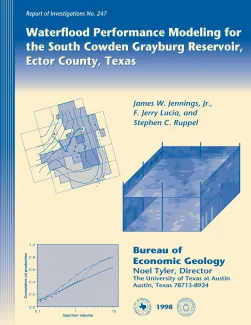
Publication Details
Geolocation:
Get the Publication
$6.50
Abstract/Description:
This Report of Investigations describes a geological, petrophysical, and reservoir engineering study of the South Cowden field, Ector County, in West Texas. This product is the downloadable version. A geological, petrophysical, and reservoir engineering study was conducted of waterflood performance in the South Cowden field, an Upper Permian Grayburg reservoir on the Central Basin Platform in West Texas. The study was undertaken to understand the historically poor waterflood performance, obtain insight on the location of remaining mobile oil, determine the parameters having the most influence on waterflood performance predictions, evaluate three techniques for incorporating petrophysical measurements and geological interpretation into heterogeneous reservoir models, and identify issues in fluid-flow scaleup and heterogeneity modeling that require further research. The approach included geological description of the field stratigraphy and diagenesis, petrophysical modeling, analysis of relative permeability data, analysis of injection and production data, heterogeneity modeling, and waterflood simulation. Partial completions, vertical permeability, and relative permeability were the most important parameters affecting waterflood performance predictions. The results were also influenced by the heterogeneity modeling procedure. The poor waterflood recovery at South Cowden is due, in part, to completion of production and injection wells in only the top half of the formation; some of the remaining mobile oil is located in the poorly swept bottom half of the reservoir. Recompletion of wells through the entire formation is estimated to improve recovery in 10 yr by 6 percent of the original oil in place in some areas of the field. All the flow simulations required a vertical-to-horizontal permeability ratio (kv l kh) smaller than that measured in whole core to explain waterflood behavior, suggesting the presence of barriers to vertical flow not explicitly accounted for in any of the heterogeneity models. The flow simulations also required modifications to the measured steady-state relative permeabilities, suggesting that small-scale heterogeneities and scaleup are significant. Vertical flow barriers, small-scale heterogeneity modeling, and relative permeability scaleup require additional research for waterflood performance prediction in reservoirs like South Cowden. One of the heterogeneity models used in the study was based upon stochastic three-dimensional sequential-Gaussian simulations conditioned to well-log data. This model produced the best fit to waterflood performance and injectivity, but a simpler model based on two-dimensional smooth mapping of vertically averaged properties within each high-frequency cycle was almost as good. The results reaffirm the importance of large-scale heterogeneities in waterflood modeling but demonstrate only a slight advantage for stochastic modeling at this scale.